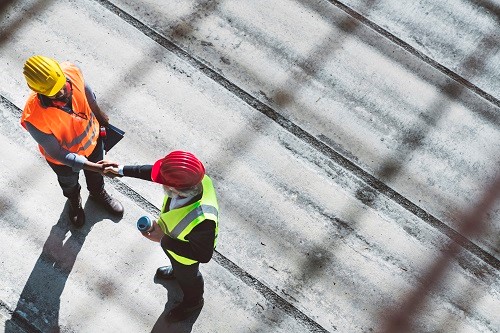A new charter and benchmarking scheme aims to encourage all stakeholders in the built environment industry to develop the necessary leadership and culture to put people’s safety first in how we design, build and maintain the built environment.
Features
Building a safer future
In recent years, the built environment industry has been focusing on improvements to occupational health and safety and the welfare of site workers.
Everything from working at height, to lifting operations, traffic management, materials storage and countless other aspects of site work have all been subject to attention when it comes to risk management and reduction.
This focus has led to a nationwide downward trend in fatal injuries over time – with the rate reducing from 7.9 to 1.5 fatal injuries per 100,000 workers since 1981, and the rate of self-reported non-fatal injuries showing a similar downward trend. This is something the industry should be proud of.
 A new charter and benchmarking scheme aims to encourage all stakeholders in the built environment industry to develop the necessary leadership and culture to put people’s safety first. Photograph: iStock
A new charter and benchmarking scheme aims to encourage all stakeholders in the built environment industry to develop the necessary leadership and culture to put people’s safety first. Photograph: iStock
However, building safety has not had the same level of attention or scrutiny over the same time period – that is, until Grenfell Tower caught fire in the early hours of 14 June 2017, leading to 72 deaths and an independent review that found that the leading causes of the fire were far-reaching failings of leadership and culture in relation to building safety. Dame Judith Hackitt wrote in her report that in the built environment industry: “There is insufficient focus on delivering the best quality building possible, in order to ensure that residents are safe, and feel safe.”
Dame Judith’s Building a Safer Future report was very clear that responsibility for building safety does not begin and end with construction companies, and that instead, failures of leadership and culture in many organisations involved with the building contributed to the tragedy – in her words the industry “has not reflected and learned for itself, nor looked to other sectors”.
How safe a building is, is determined right from the very start during the planning and design phase, through the construction phase and beyond handover to the ongoing running and maintenance of the building, and right the way through to demolition or de-commissioning.
This means that anyone who has responsibility for any building at any point in its lifecycle should be prioritising a building safety culture over other concerns like saving time and money – including those working in architectural design studios, on construction sites, in local authority and housing association offices, in building management companies and so on.
Most organisations are familiar with the concept of a continuous improvement culture, and have successfully applied it to various aspects of their day-to-day business activities. Now organisations are being asked to approach building safety in the same way.
It’s critical that when organisations turn their attention to building safety as a strategic business concept, they don’t view it as a means of collecting ‘badges’ or ‘trophies’, but instead as adopting a position of always looking to improve things for the users of their buildings.
Perfection doesn’t exist, so there is always a way to make things better. This includes a mindset change from aiming to achieve ‘green’ ratings and eliminating ‘red’ ones, to instead ‘celebrating the reds’ (recognising that each ‘red’ discovered is an opportunity to improve), and ‘challenging the greens’ (understanding that a ‘green’ rating isn’t an endpoint because even areas of strength can be improved upon).
 Perfection doesn’t exist, but there is always a way to make things better. Photograph: iStock
Perfection doesn’t exist, but there is always a way to make things better. Photograph: iStock
The Building a Safer Future Charter, with its five key commitments (see here), was developed by a group of early adopters including four Tier 1 contractors, four housing associations and four local authorities as an early response to Grenfell, providing a rallying point for the industry in those early days following the tragedy.
Building a Safer Future Ltd (BSF) was then created as an independent organisation and appointed following an open recruitment process to take responsibility for managing the Charter and developing it into a tangible mechanism to provide the much-needed culture change within the sector.
As a not-for-profit, BSF constantly re-invests money back into the scheme, widening its accessibility to different types of organisations and updating its framework in line with new legislation and industry requirements as they are introduced.
BSF has created two ways that organisations can engage with the Building a Safer Future Charter – demonstrating their commitment to building safety to both the industry and the public at large. The first is as a Registered Signatory – signing a public declaration to embed the five key commitments into all their business strategies and activities. The second and more involved level of engagement is applying to take part in the Building a Safer Future Champion process.
 The BSF Champion process has been designed to support organisations in their building safety continuous improvement journey. Photograph: iStock
The BSF Champion process has been designed to support organisations in their building safety continuous improvement journey. Photograph: iStock
In developing the Champions framework, BSF has reviewed how other sectors – such as oil, gas, chemicals and rail – have acted in the wake of their own major disasters, where, like Grenfell, failures of leadership and culture were identified as key underlying causes. Their tried and tested approaches to improving safety have been analysed and adapted to be relevant to the safety-critical UK built environment sector.
With leadership and cultural improvement at its heart, the BSF Champion process has been designed to support organisations in their building safety continuous improvement journey, providing valuable insight and prioritisation methodology in identifying areas of strengths and opportunities for improvement.
Those who have already embarked on the process are seen as leaders in the industry, and organisations such as the Building Safety Regulator, Health and Safety Executive, Construction Leadership Council, Homes England and Crown Commercial Services positively endorse and support the scheme.
The central ethos of the BSF Champion process is that it is not an audit or a test that organisations can pass or fail to prove their building safety credentials, but instead a valuable tool to assist them to improve their leadership and culture and support them on their building safety continuous improvement journey – no matter from what point that journey starts.
An experienced, independent assessor is appointed right from the outset, and their role is to provide support and guidance throughout the whole course of the assessment. This independent, third-party validation is key to the process – as it is not industry marking its own homework.
The outputs are in-depth, data-driven narrative reports written by senior figures in high hazard industries. Organisations can also choose to keep their participation in the scheme confidential if they so wish, while still benefiting from the insight and experience of their assessor.
The Champion assessment is divided into two modules – the first entitled ‘Leadership and Culture’ and the second, building safety critical ‘Corroborating Elements’. Both stages align closely to the 53 recommendations in Dame Judith Hackitt’s report and to the Fire Safety and Building Safety Acts.
 Gary Townsend Vila: "How safe a building is, is determined right from the very start during the planning and design phase, through the construction phase and beyond."
Gary Townsend Vila: "How safe a building is, is determined right from the very start during the planning and design phase, through the construction phase and beyond."
The Leadership and Culture module ascertains the perceptions of the organisation’s workforce regarding the commitment of the leadership to building safety, and the organisational culture that results. This is incredibly important because internal company surveys are often limited in scope and sometimes risk employees submitting responses that are not as truthful as they could be, if they are concerned they could be identified from their answers. BSF maintains the utmost confidentiality, thus preserving the integrity of the data, and providing an independent eye to analyse it.
Assessors also undertake validation discussions with a sample of the survey respondents – delving deeper into the stories behind the data and unpicking why people feel the way they do. The findings all go into the Leadership and Culture report – a report that a construction industry consultant organisation that has recently been awarded Champion status described as “a detailed appraisal against objective criteria [forming] a strong foundation from which to implement structured and targeted plans for continual improvement”.
The second module – Corroborating Elements – revolves around how building safety critical policies and processes are implemented within the organisation, and requires respondents to complete a self-assessment against a number of expectations that are tailored towards their specific business activities.
The process is open to a broad swathe of organisations in the built environment industry, including building owners and building management companies, contractors, lead designers, consultants, housing associations and social housing providers, local authorities and construction and procurement frameworks.
Again – there is an ongoing dialogue with the assessor throughout, helping organisations to reflect their best selves and gain valuable understanding of what is happening in their company. The Corroborating Elements report compares the company’s assertions against their assessor’s, and includes quality insight and analysis regarding the strengths and opportunities for improvement.
The framework is strongly aligned to both existing legislation and ensures (as far as possible) readiness for forthcoming secondary legislation – a prime example of which is the Corroborating Elements expectation for an embedded process for the Golden Thread including the use of digital technologies, as recommended in the Hackitt report.
The BSF Champions programme helps participating organisations reduce their overall risk profile, gain greater oversight and governance of risk, and get ahead of regulation in a very practical and supportive way. BSF’s requirement for Champions to commit to the journey includes the expectation that organisations will compile and action a continuous improvement plan using the findings from the two reports – a plan that the assessor will return a year later to measure improvement against. BSF is not looking for perfection in its Champions, but rather a commitment to building safety and to continuous improvement in this area.
The testimonials of the Champion process are glowing. One major housebuilder commented that they “are always seeking opportunities to strengthen [their] approach to building standards and safety and BSF’s scrutiny through the Champion assessment has helped drive further change and improvement”, while a social housing provider asserted that the “BSF Champion process has been extremely valuable, not only in helping to highlight where we’re getting things right, but also to help demonstrate how we can make immediate and long-term improvements across the organisation”.
The message is clear. Industry leaders are demanding changes to building safety culture, and engaging in the BSF Champions process is the best way organisations can achieve this. As Dame Judith Hackitt herself said: “We now need many more to commit to following the example […] of driving culture change for the right reasons rather than waiting for regulators to drive the change.”
It’s time for the built environment industry to recognise itself as high hazard and to embark on the journey of reducing the risk to life of their building residents and users. For this to become reality, every single organisation within the built environment sector needs to share the vision of a safer future and actively work towards it. The Champions process is the ideal way to do this.
Organisations can apply to participate in the BSF Champions programme by visiting the Building a Safer Future website and completing the application form at: buildingasaferfuture.org.uk
Alternatively email: [email protected]
Gary Townsend Vila is Interim chief executive at Building a Safer Future
FEATURES

Sedentary working and how to combat the ‘sitting disease’
By Gavin Bradley, Active Working on 05 April 2024
Prolonged and excessive sitting poses a major risk to our health, but the Get Britain Standing campaign and On Your Feet Britain Day on 25 April are a great way of encouraging workers to sit less and move more.

Company culture and wellbeing: a crucial link
By Bex Moorhouse, Invigorate Spaces on 05 April 2024
Investing in measures to support worker wellbeing will be ineffective unless the company culture genuinely incorporates values like teamwork, involvement, flexibility and innovation.

Office design and culture: happier and healthier staff – or the opposite?
By Guy Osmond, Osmond Ergonomics on 03 April 2024
Applying ergonomic principles to workstation set-ups and ensuring the physical environment supports neurodivergent people are just some of the ways of creating an office where everyone can thrive, but a supportive and positive organisational culture is vital too.


